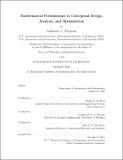Mathematical Formulations in Conceptual Design, Analysis, and Optimization
Author(s)
Norheim, Johannes J.
DownloadThesis PDF (6.678Mb)
Advisor
de Weck, Olivier L.
Terms of use
Metadata
Show full item recordAbstract
Engineering design problems are often multidisciplinary in nature, giving them a natural decomposition into subproblems. The field of multidisciplinary design, analysis, and optimization (MDAO) has developed methods to integrate these sub-problems and generate standardized mathematical formulations. In the detailed design phase of engineering, multiple technical reasons beyond the nature of the discipline justify the decomposition. However, in the early phase, during conceptual design, when the models involve equations or constraints on elementary functions with highly heterogeneous structures, multiple decompositions are often possible. Furthermore, the decompositions often involve inversions of the elementary functions, leading to a restructuring of the design equations. Applying MDAO methods to specific decomposition choices can lead to mathematical formulations with fewer variables and constraints or equations, which are often desirable properties. This thesis explores how to restructure the conceptual design equations and generate different mathematical formulations based on the same underlying model. For this purpose, we develop a new graph-based mathematical formalism, which generalizes many of the existing MDAO methods through a set of atomic transformations. We find desirable problem structures by solving different combinatorial optimization problems related to the well-known feedback arc set and assignment problems. The formulations of the optimization problems seem to be exponential on average but make it possible to find optimal structures with 30 variables in less than 1 second. Finally, we apply the restructuring method to three conceptual design problems from aerospace and naval engineering domains, with up to 40 sizing relationships. In all but one case, we find feed-forward structures. Although the restructured problems have the desired properties, a new set of unexpected numerical challenges results in some cases.
Date issued
2022-09Department
Massachusetts Institute of Technology. Department of Aeronautics and AstronauticsPublisher
Massachusetts Institute of Technology